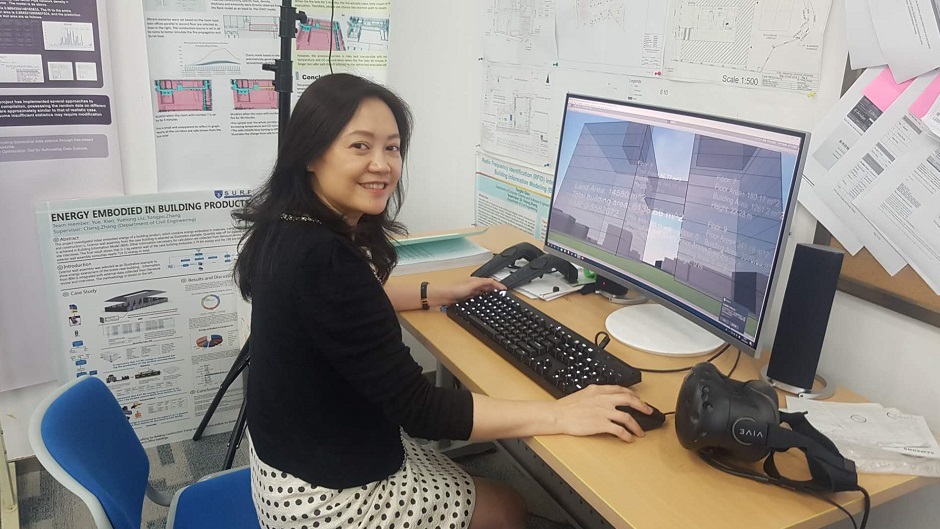“We live in a smart world – we have smartphones, smart buildings, smart cities. Let’s create smart construction as the foundation for the digitally-Dr. iven era we now live in.”

These are the words of Xi’an Jiaotong-Liverpool University researcher Dr. Cheng Zhang, who will deliver a talk on her work at the launch of the University’s Research Festival on May 20 at the University’s International Research Building.
Based in the Department of Civil Engineering, Dr. Zhang says smart devices and systems evaluate the environment around them using data, which in turn helps us as humans make better decisions. Increasingly, she says, these smart devices are even capable of making decisions themselves.
“My focus is on using technology to create smart construction and safer, more productive construction sites that use data, algorism and systems to improve worker safety and building efficiency,” she says.
“Automation is widespread in many industries such as manufacturing, where entire factories run on technology-Dr.iven assembly lines, but in construction, automation is in its early stages. The industry is still highly labor-intensive.
“The vision is to one day have a smart construction site that is designed and managed by technology at every stage of the building process with robots, rather than humans, undertaking the physical work and the design and planning done by smart systems – in partnership with humans.”

Dr. Zhang (pictured above) says this vision is still a long way off but she is currently working on developing a dynamic building information model that adapts to each stage of the building lifecycle, from design to ongoing facilities management.
“Building information models (BIM) are widely used in the construction industry but they can only illustrate a completed building model,” she says.
“The dynamic BIM we are creating is instead a 3D model that reflects the building at its current stage, not just the finished product.
“Using real-world data gathered through a variety of technologies, the dynamic BIM would provide designers, engineers, and builders with a detailed model as it exists physically on the building site, even if it is only partially completed.”
According to Dr. Zhang, building sites are places of constant change and the dynamic BIM offers a platform with smart elements that allows workers, such as engineers, to evaluate a building’s overall progress, assess safety and risks, and get accurate dimensions and locations of materials and components.
While a number of tools already exist to gather the type of data a dynamic BIM needs, such as 3D laser scanners and cameras, Dr. Zhang says it is often missing crucial semantic information, making it difficult for computer systems to extract relevant data.
“This is where our research comes in. We are creating algorithms for various data sets, such as optical and thermal images, to essentially tell the computer what it needs to create a dynamic BIM,” she says.
“What that looks like in the construction setting is that an optical image might ‘tell’ the computer what it’s looking at broadly and then a thermal image can identify what material the computer is looking at, as each material has different properties and therefore displays as a different colour.
“We then implement artificial intelligence techniques to ‘teach’ the computer to recognise the difference between common components in a building site, such columns and beams.
“Our goal is to create a virtual world that matches the real world, which offers a number of benefits at all stages of the construction process.
“In the area of health and safety, the dynamic BIM is capable of identifying that an elevator shaft has been created but there is no elevator installed yet, creating a dangerous hole on the building site.
“The site manager is instantly notified and the dynamic BIM will automatically suggest, through virtual fencing, areas of the construction site that need to be cordoned off.”
While Dr. Zhang sees huge potential for technology to transform the construction industry, she stresses that humans will always remain an essential part of the building process.
“By harnessing technology, we can create smart construction that boosts productivity, enhances safety and improves overall quality, creating a better built environment for everyone,” she says.
Dr. Zhang is one of a number of XJTLU academics presenting their work as part of the Research Festival, which also includes a XIPU Forum run by the University’s think tank, the XIPU Institution. The Festival is designed to celebrate the research achievements of the University and showcase the innovation happening on campus under the overarching theme of ‘Breaking the Boundaries.’
The event is open to the public, as well as the University community. To register to attend, go to the Research Festival website.
Original Article From: https://www.xjtlu.edu.cn/en/news/latest
Learn More and Apply: Xi an Jiaotong-Liverpool University




















